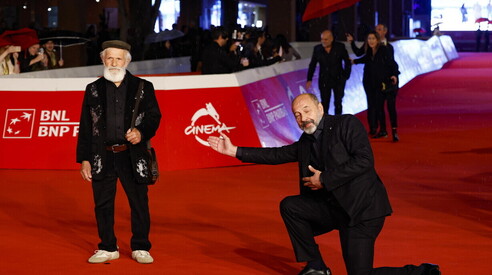Elegance is a form of calm. Giuseppe Ignazio Loi speaks.


Ansa photo
the fashion sheet
How to get many truths about fashion revealed by an eighty-five-year-old who has always been a shepherd and who for two months has been highly sought after on the catwalks and red carpets, testimonial for Antonio Marras and protagonist of "La vita va così"
There are faces that seem to be created by the wind rather than by time. That of Giuseppe Ignazio Loi , eighty-four, a shepherd from Terralba, a village twenty kilometers from Oristano, belongs to that lineage of men who move not to arrive, but to stay. One day, fashion and cinema took notice of him, but instead of changing him, they were changed by him or, in different ways, influenced by him. His face, gaunt and quiet, is the focus of Riccardo Milani's new film, "La vita va così," released by Medusa Film and PiperFilm and much loved by audiences. The film is inspired by the story of Ovidio Marras, the shepherd who for years opposed the construction of a gigantic tourist village near the beach of Tuerredda, in southern Sardinia . Loi plays Efisio Mulas, Marras's alter ego, alongside Diego Abatantuono, Aldo Baglio, Geppi Cucciari, and Virginia Raffaele. This is her second time playing a woman fighting for the defense of rural society, following the highly successful "A World Apart," which must therefore have inspired Milani to write a parallel screenplay, also starring the same lead. But for Loi, even before cinema, there was fashion.
At Antonio Marras's Spring/Summer 2026 fashion show in Milan, in the former Magazzini Generali, set with mountains of sand, salt, and books, a nod to the journey that, in January 1921, the writer D.H. Lawrence and his wife Frieda von Richthofen, the "Queen Bee" of countless letters and stories, took along the coast and inland of Sardinia, which was later captured and sublimated in the diary "Sea and Sardinia." In that setting, reinterpreting a historical episode with the tones of legend, or of the theatrical spectacle that has become the Sardinian designer's signature, Loi entered with a slow but determined stride, wearing a hand-embroidered olive green jacket, with no pretense other than to be recognized and validated as the shepherd he is. And with him, on the catwalk, came the mountains, the pastures, the rough hands, and the seasons—the deepest Sardinia, not the picture-postcard one, but the one that endures. His journey thus became a secular liturgy, an act of restitution. Marras elevated him to the status of ambassador of a beauty that is not measured in meters of fabric, but in centimeters of truth: a beauty that is not photographed, but listened to . In that gesture, in the apparent simplicity of a man who passes through the space of luxury without being swallowed up by it, there was a statement, because, as we know, fashion can be political, poetic, and civil, a space of preservation, not consumption. At the end of the show, Marras and Loi greeted the audience together, while Rita Pavone's "Questo nostro amore" resounded in the air, chosen as the final soundtrack. The moment, suspended and so sweet, ended up transforming the catwalk into a story, the slowness of the shepherd a measure of time and beauty a memory. "For me, that was a dress like any other," Loi told "Foglio della moda" with absolute seriousness. “I didn't feel out of place, on the contrary. I thought: I'll just walk, like I've always done in life. Elegance, if it exists, is a form of calm.” A few weeks later, with the same slow pace, he returned to the red carpet at the twentieth Rome Film Fest, where “Life Goes That Way” was the opening film. When we met him, it was clear that the very idea of being seen was foreign to him. “I don't understand anything about fashion,” he smiled, showing off his black velvet jacket with flowers. The fabric is reminiscent of us Sardinian men, but we don't go around like that, even though I'd like to. Marras promised me he'll make me one." He adds: "Mine has been a life all home/work, or rather, all countryside: for me, clothes are just necessary rags," unaware that, for at least half a century now, it's become a fashionistas' habit to call clothes that way. Rather than acting, Loi preferred to "inhabit" his character, and hearing him tell it all, it seems to have been very simple. "I read the script, but I didn't force myself to learn everything by heart. It came from within. I've been a shepherd for seventy years: you either feel the land or you don't, you can't fake it. And so I acted with the words I felt like saying, without pretense. Then I got a call from a cousin in Terralba who put me in touch with Riccardo's team for the auditions, and that's how this beautiful story began."
After observing him, the director wanted him immediately, sensing that this man, with his silences and essential gestures, would embody the measure the film was seeking. "It was all natural, I had a lot of fun," Loi continues. "The scene that remains in my heart is the one where they offer to sell me the land and I turn them down. In that moment, I saw myself again. When I say no, I mean it." Saying it is the most complicated thing, we point out. And he: "For me, it's the opposite. It's easy for me to say no; it's my form of freedom."
After filming, fame came with Abatantuono, who nicknamed him "the De Niro of Terralba." "At first I thought he was joking, then I realized he was really happy with my work," confesses Loi, who was moved several times at the Roman premiere. "The flashes on the red carpet were so bright they blinded me. On the way to the theater, I closed my eyes and those lights looked like stars. I got emotional three or four times. When the applause began, I couldn't believe it. I think I'll watch the film every day, even though it's in my head now." Yet, behind the emotion, there remains a man who refuses to be dazzled. "Tomorrow I'm going back to my countryside," he said after the gala dinner at the St. Regis Hotel, and he truly did, disappointing the organizers of breakfasts and dinners downtown, in Parioli or on the Appian Way, who, in the not-so-cruel game of social trading cards, "I have it/I don't have it," would have greatly appreciated the archetypal shepherd. "My house is in the middle of the fields, and I'm happy there, surrounded by my cats and my plants; the pomegranate tree is my favorite. I live alone, with only my sister and a niece who lives in Cesenatico. If I'm in company, I'm happy, but if I'm alone, I'm happy just the same. I lack nothing: I have my pension and a little money from the film, but that's not what matters." A landscape, his, which we find on his face seems to encompass the entire Campidano, the largest plain in Sardinia, with its wind, its stone, and its light that changes with the time of day. When in the film he utters "Custa est domu meu," Loi isn't defending a border, but a fragile and sacred balance between man and earth. His journey from the flock to the set, from the countryside to the catwalk, tells us much more than we expect. In a world that idolizes visibility, he represents the strength of discretion, because he is a man who enters the circuit of fame without dissolving into it. His power lies in subtraction, in the ability to remain still, even while everything around him moves. "From my profession, I learned that courage lies in character," he says. "As a boy, I had a lot of it, and I haven't lost it. It's what keeps me standing, like sheep in a storm." In his way of being in the world, we recognize that "simple depth" Merleau-Ponty spoke of: the truth that resists noise.
More on these topics:
ilmanifesto




